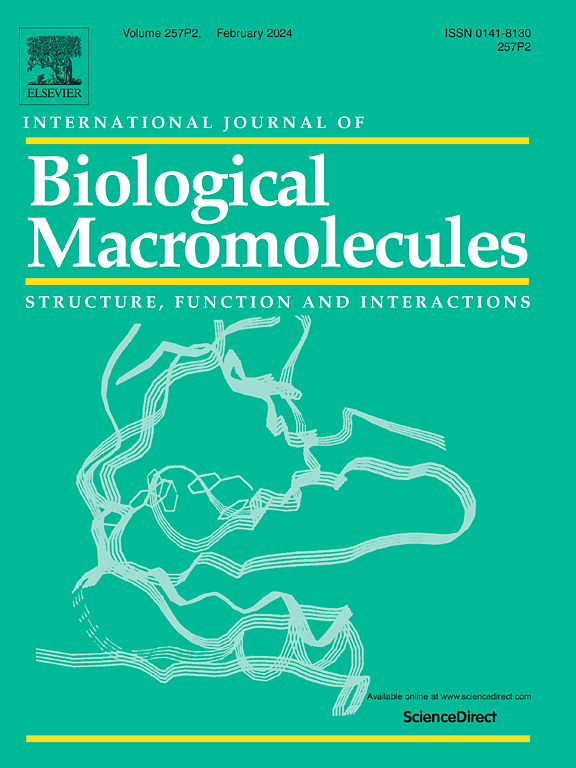Investigation of mono-nuclear cobalt(II) complexes with a tri-dentate quinoxalyl-hydrazone ligand for their potential in biological research and interaction with ct-DNA.
IF 7.7
1区 化学
Q1 BIOCHEMISTRY & MOLECULAR BIOLOGY
International Journal of Biological Macromolecules
Pub Date : 2025-02-01
DOI:10.1016/j.ijbiomac.2024.138617
引用次数: 0
Abstract
The condensing reaction of 2-hydroxy-1-naphthaldehyde with quinoxalyl-2-carbohydrazide resulted in synthesizing of a novel derivative of hydrazone quinoxalyl ligand (H2dpq). The bonding behavior between H2dpq and Co(II) ion was investigated in molar ratios of 1: 1 and 2: 1 to produce two different complexes, Codpq and Co(dpq)2, respectively. Their chemical structure was verified using several spectroscopic approaches. The characterization envolved micro-C, H, and N-elemental analyses, thermogravimetric investigations, as well as the examination of their magnetic and conductance properties.
The inhibitory effects of H2dpq (the free ligand) and its Co(II)-chelates on the growing up of three specific bacterial series, three specific fungal series, and three famous human cancer cell lines were evaluated based on their structure features. The study referred to the pivotal function of Co(II) and its ratio in the two complexes. The antioxidant activity was determined for all current compounds within DPPH and SOD assays, reporting respectable antioxidant reactivity. The interaction of H2dpq, Codpq, and Co(dpq)2 with calf thymus DNA (ct-DNA) was assessed by analyzing through the alterations in the viscometric and spectrophotometric properties. Determination of binding constant (Kb, 13.12, 16.02, and 16.82 × 107 mol−1 dm3), Gibb's free energy (, were −40.21, −46.13, and −46.67 kJ mol−1), and the chromism mode (hypo-character) were employed for H2dpq, Codpq, and Co(dpq)2 to assess the interactive modes, respectively. Rewardingly, the monometallic-chelates Co(II)-complexes displayed modified binding action more than that of H2dpq against ct-DNA.
研究具有三齿喹喔啉-腙配体的单核钴(II)配合物在生物研究中的潜力以及与 ct-DNA 的相互作用。
2-羟基-1-萘醛与喹草酰-2-碳酰肼缩合反应,合成了一种新型腙基喹草酰配体衍生物(H2dpq)。研究了H2dpq与Co(II)离子在1:1和2:1的摩尔比下分别生成Codpq和Co(dpq)2两种不同配合物的成键行为。它们的化学结构用几种光谱方法进行了验证。表征包括微量c, H和n元素分析,热重调查,以及它们的磁性和电导率的检查。根据游离配体H2dpq及其Co(II)-螯合物的结构特点,评价其对3种特定细菌系列、3种特定真菌系列和3种著名人类癌细胞生长的抑制作用。研究了Co(II)的关键作用及其在两种配合物中的比例。在DPPH和SOD检测中,测定了所有当前化合物的抗氧化活性,报告了可观的抗氧化反应性。通过分析H2dpq、Codpq和Co(dpq)2与小牛胸腺DNA (ct-DNA)的粘度变化和分光光度变化来评估它们的相互作用。采用结合常数(Kb、13.12、16.02和16.82 × 107 mol-1 dm3)、吉布自由能(∆Gb≠,分别为-40.21、-46.13和-46.67 kJ mol-1)和显色模式(亚特征)对H2dpq、Codpq和Co(dpq)2的相互作用模式进行评价。值得注意的是,单金属螯合物Co(II)-配合物比H2dpq对ct-DNA表现出更改性的结合作用。
本文章由计算机程序翻译,如有差异,请以英文原文为准。
求助全文
约1分钟内获得全文
求助全文
来源期刊
CiteScore
13.70
自引率
9.80%
发文量
2728
审稿时长
64 days
期刊介绍:
The International Journal of Biological Macromolecules is a well-established international journal dedicated to research on the chemical and biological aspects of natural macromolecules. Focusing on proteins, macromolecular carbohydrates, glycoproteins, proteoglycans, lignins, biological poly-acids, and nucleic acids, the journal presents the latest findings in molecular structure, properties, biological activities, interactions, modifications, and functional properties. Papers must offer new and novel insights, encompassing related model systems, structural conformational studies, theoretical developments, and analytical techniques. Each paper is required to primarily focus on at least one named biological macromolecule, reflected in the title, abstract, and text.

 求助内容:
求助内容: 应助结果提醒方式:
应助结果提醒方式:


